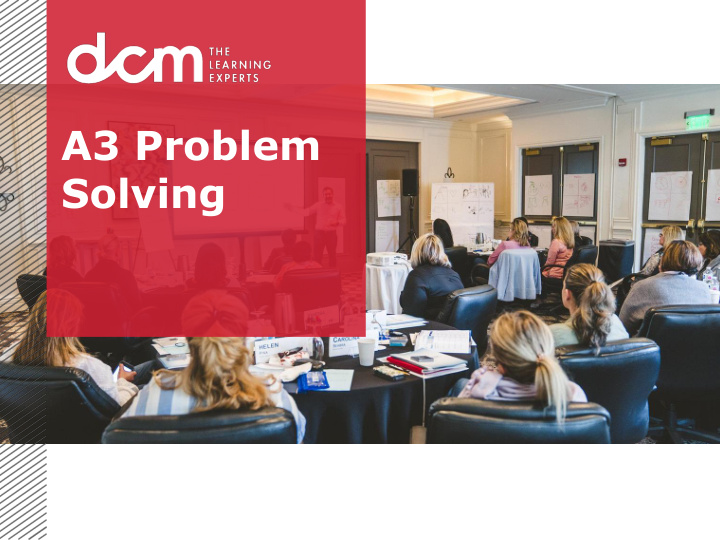



A3 Problem Solving
Trainer and facilitator Cormac Johnston
Agenda • What is a problem? • History of A3 • What is A3 thinking? • What A3 problem solving? • Why we use A3 ? • A3 story board creation
What is a problem and why is it so hard to solve ?
“It takes a different kind of thinking to solve a problem than the kind of thinking that produced the problem” Albert Einstein
History of A3 ▰ The A3 report is one of the many Lean management tools, developed as part of the Toyota Production System (TPS) ▰ The name A3 simply comes from the European A3 paper size corresponding to 11-inches by 17- inches or 29.7cm x 42cm
What is A3 Thinking ▰ Logical Thinking ▰ Present Information Objectively ▰ Process & Results ▰ Focus on Essential Data & Information ▰ Actions are consistent with company goals
What is A3 problem solving ▰ A common Format ▰ A single sheet ▰ 7 Blocks ▰ Based on PDCA Cycle ▰ Focus on understanding ▰ Advantage of planning
A3 & PDCA Cycle Implement the Countermeasures Background & Support Data ( DO ) ( PLAN ) Describe the Current state What are we trying to solve. ( PLAN ) Set Goals and Targets. Define what success looks like ( PLAN ) Follow UP ( Check ) Perform Root Cause Analysis ( PLAN ) Follow UP ( Act ) Design Counter Measures ( PLAN )
Project Leadtime DO Do Check Act Plan Project Leadtime
Why use A3 ▰ Encourages collaboration and team involvement ▰ Promotes information sharing ▰ Encourages learning ▰ Reinforces commitment to common goals
Advantages of Format ▰ Keeps everything concise ▰ A3 Model is consistent ▰ Information on just 1 page ▰ Uses Visual Charts and Graphics ▰ Encourages consensus & collaboration
Formats of A3
A3 & PDCA Cycle Background & Support Data Set Goals and Targets. ( PLAN ) Define what success looks like ( PLAN ) Describe the Current state Perform Root Cause Analysis What are we trying to solve. ( PLAN ) ( PLAN ) Design Counter Measures ( PLAN ) Implement the Countermeasures ( DO ) Follow UP ( Check ) Follow UP ( Act )
Roles in A3 Process ▰ Mentor or Coach ▰ Problem Owner ▰ Stakeholders - internal and external ▰ A3 Task Team
How to create an A3 Storyboard
Step 1 Describe the Background ▰ State the Problem & Impact ▰ Provide Context ▰ Background Information ▰ How does it relate to company goals ▰ How was it discovered ▰ How does it manifest ▰ What is the extend of the variation ▰ Present visually if possible ▰ Justify & Sell the issue
Step 2 Current Situation ▰ Visit the Problem ( Gemba ) ▰ Form a full understanding of the issue ▰ Write a Problem Statement ▰ Map the issue or process ▰ Present visually if possible
Step 3 Set Targets & Goals ▰ After the current situation is clear you need to set goals ▰ You don’t have all the information - keep this in mind
Step 4 Root Cause Analysis ▰ Conduct a RCA
5Why’s
5Why’s ▰ Why are deliveries late ▰ The driver gets lost ▰ Why does driver get lost ▰ They do not use his sat nav ▰ Why do they not use his sat nav ▰ Because they do not know how to use it ▰ Why do they not know how to use it ▰ They were never trained
Ishikawa
Step 5 Design Counter Measures ▰ Design appropriate counter measures
Brainstorming Strategies 1) Analytical 2) Role Play Brainstorming 3) Quiet Brainstorming 4) Supported Brainstorming 5) Radically Creative Brainstorming
Brainstorming ▰ Mind mapping ▰ Reverse Brainstorming ▰ SWOT Analysis ▰ 5 Why’s - already looked at ▰ Roleplay Brainstorming
Step 6 Implement Counter Measures ▰ Set up a blank register ▰ Use 4-5 counter measures ▰ Define ▰ What ▰ Who ▰ When ▰ Set follow up schedule
Step 7 Follow UP / Verify ▰ Compare plan to actual ▰ Establish a new A3 ? ▰ Lessons learnt
Learnings
Key Points A3 ▰ A3 thinking is more than just filling out an A3 report ▰ Stops haphazard problem solving ▰ A3 thinking is a structured thought process that is based on the PDCA cycle. ▰ The A3 process is not an individual activity. It requires the effort of the whole team, including stakeholders
Key Points A3 Thinking ▰ No problem is ever fully resolved ▰ Make the target specific / have clarity to what agreed ▰ Don’t expect to be an A3 expert immediately. ▰ Think about the process not the report ▰ Use imagery they are clear than words
What to learn more www. dcmlearning.ie Dublin Cork 01 524 1338 021 242 9691
Recommend
More recommend